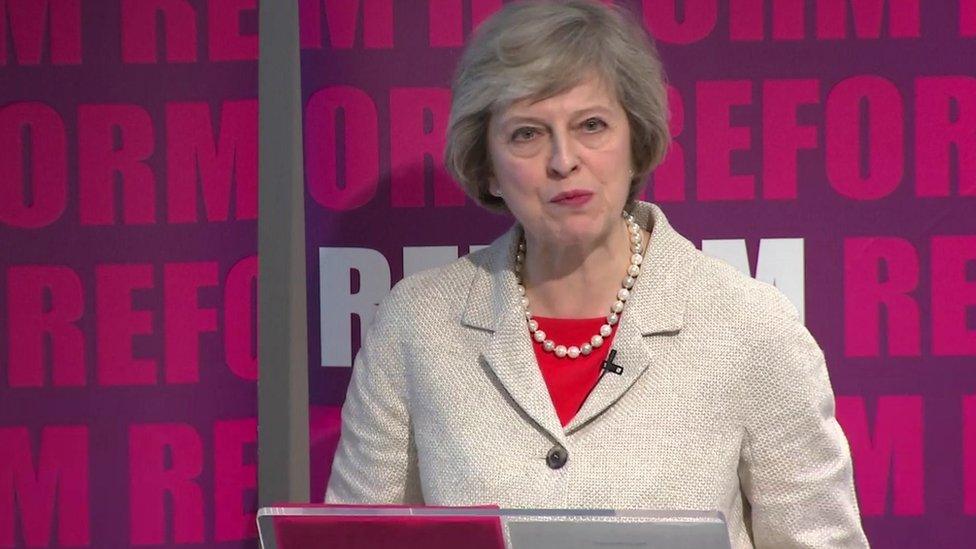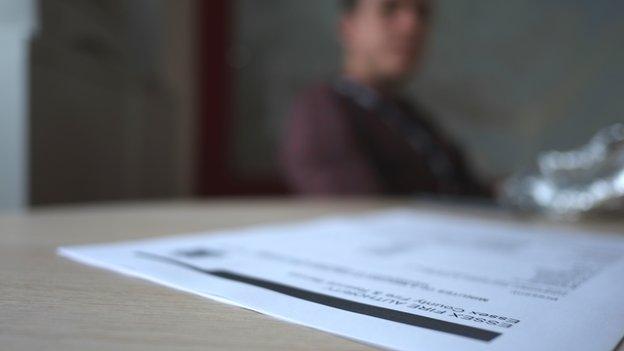Theresa May reveals 'radical reform' of fire services in England
- Published

Theresa May announced a "radical reform" of fire services in England during a speech in London
Home Secretary Theresa May has called for an end to what she described as a "culture of bullying and harassment" in parts of the fire service in England.
She has revealed "radical reforms" for the service, including new inspections, but warned of "further savings".
She said the diversity of the 96% white, 95% male workforce should also be transformed.
But Matt Wrack, of the Fire Brigades Union, said the service would not cope with further cuts.
'Greater accountability'
In a speech in London, external, she announced she will publish data to show how much each fire and rescue authority is paying for items including uniform, kit, and vehicles to "help services work together to buy equipment and services".
Information will also be published to allow members of the public to compare their performance and value for money and diversity.
Mrs May said the fire service had a "fine tradition and a proud record" but "there remains much more to do".
Announcing "a rigorous and independent inspection regime", the home secretary said she will make amendments to the Policing and Crime Bill to "put beyond doubt" the powers of fire inspectors to access information, and to ensure the government has the power to commission inspections.

Analysis

By Danny Shaw, BBC Home Affairs correspondent
For the past six years her focus has been on police reform.
Now Theresa May has turned her attention to the fire service, for which her department assumed responsibility in January.
The home secretary's plans for change are driven in part by the need to save money. But Mrs May also wants to shake up the culture of fire and rescue - laid bare in a scathing, but little publicised, report last September into Essex fire service.
To those familiar with some of the less savoury aspects of policing, the descriptions of what went on in Essex have a sense of deja vu.
The question is how much Mrs May will be able to achieve given there is opposition in some quarters to her plans to give police and crime commissioners powers over local fire brigades and a suspicion that closer working between police officers and fire fighters could result in a dilution of their respective skills.

She also highlighted a "widening disparity" between the pay of chief fire officers in different parts of the country - "with little relationship to their skills, performance or the size of the role".
The Policing and Crime Bill, which is making its way through Parliament, will also allow Police and Crime Commissioners to take on responsibility for fire services to bring "greater accountability".
Mrs May is only announcing changes in England - as control for fire services is devolved to the four nations of the UK.
'Worst austerity cuts'
Mrs May said although fire authorities had "shouldered their fair share" in making savings, "further savings will need to be made" over the next four years.
But she said her plan "does not and should not mean a reduction in the quality of frontline firefighting".
"Just as we have seen in policing, it is possible to protect the frontline and increase the proportion of officers deployed in frontline roles even as savings are made," she said.
But Mr Wrack said: "The truth is we've had the worst austerity cuts on record and that has been reflected in a record number of fire stations closed, a record number of fire engines being axed and a record number of firefighter jobs being cut."

Becoming a firefighter
The process of joining the Fire and Rescue Service varies throughout the UK but all candidates have to go through a series of physical, psychological and medical tests.
No formal qualifications are required but candidates must complete written exams which test maths and problem solving skills
The National Firefighters Questionnaire is another test used to assess an applicant's attitude and motivation
To pass the physical test candidates must complete tasks such as a ladder climb, dragging a 55kg (8st 9lbs) casualty around a 30m course, crawling round a course wearing breathing apparatus while performing tasks with both clear and obscured vision, assembling and disassembling an item of equipment and dragging and carrying various lengths of hose and equipment up to 30kg in weight around a course
Firefighters require good vision in both eyes. Medical tests also look at hearing, stamina and lung function
The minimum age to join the fire service is 18 but there is no upper age limit
There is also no minimum or maximum height requirement

Sir Ken Knight, former chief fire and rescue adviser for the government, said: "We need targets that fit the local communities, set by the local fire and rescue service authority so that it meets the community that it serves.
"And top-down targets by central government frankly don't work and it's got to be in the will and the gift and the DNA of the organisation to want to reflect the community it serves, both in fire safety, as well as the response."
- Published12 March 2016

- Published5 January 2016

- Published19 December 2015

- Published2 September 2015
